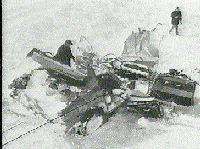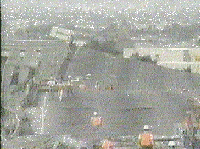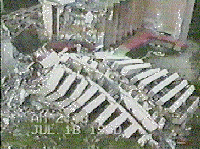

Nature's Oddities & Furies
(This page is in 5 parts to make loading faster.)
Just as we have little concern for Nature and her surroundings, so does she for us when changes must be made. Storms are disturbances of the atmosphere, accompanied by strong winds and often by some form of precipitation such as rain or snow.

Avalanche
A mass of snow and ice moving rapidly down a mountain slope. An avalanche occurs when a mass of snow and ice becomes unstable or too great for the slope on which it rests. They are often triggered by the fall of new snow, abrupt rises in temperature (causing melting), strong winds, earth tremors, and even violent sound waves, such as those caused by explosions. In descending, an avalanche may grow to enormous size by picking up additional snow, rock, and debris. Avalanches are sudden, violent and destructive.
Avalanches . . .

race downward, |

destroys what lay in their path, |

cause death, |

and force rescues. |
Did you know: An avalanche can move as fast as 200 mph.

Blizzard
A blinding snowstorm with cold, high winds. This dangerous winter storm is accompanied by low temperatures, strong winds, and falling, blowing, and drifting snow.
Did you know: In March 1888, a blizzard swept through the northeastern United States, paralyzing New York City with snow drifts ranging up to 30 feet and more than 400 people lost their lives.

Cyclone
A system of winds in which air moves around a central area of low pressure. The term cyclone is usually used to refer to very large systems of winds that can cover an area of 500 miles or more in diameter. They often occur along the boundary between cool and warm air masses in the middle latitudes of the northern hemisphere. Cloudy weather and widespread rain or snow typically occur in a cyclone.
Cyclones . . .

remove rooftops, |

destroy entire cities, |

remodel villages, |

and level buildings. |
Did you know: A cyclone spins counterclockwise in thenorthern hemisphere and clockwise in the southern hemisphere. A small, gentle cyclone is called a Dust Devil.

Earthquake
A shaking of the earth's surface. Earthquakes have toppled entire cities, killed thousands of people and animals, and caused disaterous fires and oceanic waves. Theory has it that the earth's crust is formed by a number of large plates the move very slowly in various directions on the earth's surface. As one plate pushes past or over another, great stresses build in the edges along the plates because friction prevents them from sliding past each other. Eventually the stresses become great enough to rupture the rock and the plates slip a short distance in opposite directions causing an earthquake. Some earthquakes are caused by the flow of lava beneath the surface during volcanic activity. Here are the most severe earthquakes ever recorded:
Earthquakes . . .

ribbonize highways, |

topple bridges, |

turn railroads into rollercoasters, |

and knock over buildings. |
Did you know: The San Andreas Fault in California is more than 500 miles long. An earthquake can move as fast as 2 miles per second. An earthquake can unleash as much energy as a one mega ton explosion. The San Andreas Fault produces a major quake on an average of every 130 years.
Every life counts

to a hero.

This page hosted by![]() Get
your ownFree Home Page
Get
your ownFree Home Page